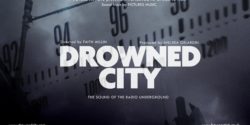I’m delighted to keep stumbling upon video artifacts of pirate radio, like the 1970s Portland public access footage and 1990 shortwave pirate documentary I recently shared. Next up I’ve found a more contemporary documentary from 2014 looking at London’s pirate radio scene.
The city has long been a hotbed of unlicensed radio activity, such that the scene birthed and nurtured new music genres like jungle and grime in the 1990s and early 2000s. The film “Drowned City” (available for free on Vimeo) takes a survey of current and former pirate broadcasters in East London, featuring a remarkable degree of access that’s facilitated by hiding the identities of many players.
Towards the start of the film, a former pirate named Jay drives director Faith Millin and her crew around East London pointing out broadcast aerials mounted on top of residential tower blocks (similar to public housing complexes in the U.S.). He notes that many of them are affixed to legitimate antenna masts used for purposes like two-way taxi radio. Even with the density of unlicensed broadcasters in places like Brooklyn and South Florida, I doubt there’s anywhere in the States where such an “aerial tour” would be so easy.
We also follow current broadcasters who have metal parts fabricated for their own home-brew security devices to stop both the authorities and competing stations from tampering with or seizing their equipment. Due to the size of the scene, as well as the heated cat-and-mouse game with Ofcom, the UK radio regulator, and police, pirates keep their transmitters cited away from studios, linking them via internet streams. This helps protect DJs, though it also means transmission gear is left unattended and vulnerable.
Though more sophisticated and mature than in many other cities, the pirate radio scene in London is born from the same seeds as elsewhere: people and communities without access to their own media taking the means to broadcast into their own hands. The success of pirate stations playing hip-hop, R&B, soul and reggae music unheard elsewhere on the radio prompted the BBC to launch 1Xtra, which focuses on urban music and has DJs who are former pirates.
While this may have taken some wind out of the pirate sails, a broadcaster in “Drowned City” notes that stations serving immigrant diasporas from Turkey and Africa have filled in some of the gaps. Again, this is similar to unlicensed broadcasters in the U.S. serving cultural and language minorities otherwise unheard on the dial.
Some of the DJs in the film have been caught and fined, and others are less sanguine about the future of pirate radio in the face of the internet. Yet, others press on, despite the risks and competition for listeners’ ears. “Drowned City” is a fascinating hour-long journey into one of the most iconic broadcast communities in the world.



